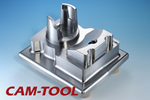CAD/CAM Software Update Further Streamlines Moldmaking Efficiencies
IMTS 2024: CAM-Tool V20 is presented by CGS North America, combining efficiency, precision and advanced AI capabilities to better tailor to specific mold builder needs.
Share
Read Next

Source | CAM-Tool by CGS North America
Mold builders can look forward to the unveiling of CAM-Tool V20, the latest version of CGS North America’s CAD/CAM software. Differentiated by its precision and toolpath generation features, this version includes a new five-axis roughing feature, which consolidates what used to be a series of separate processes for each cutting direction into a single, streamlined operation. This innovation translates into time savings and improved workflow efficiency for moldmakers.
CAM-Tool’s five-axis roughing automatically generates efficient and safe tool paths from the top, then in the X and Y positive and negative directions, using advanced algorithms to avoid tooling interference.
The comprehensive approach ensures complete material removal while maintaining high precision, which CGS notes is crucial for achieving desired mold geometries. Additionally, the software includes advanced algorithms to avoid tooling interference, protecting cutting tools and workpieces from potential collisions, enhancing safety and reducing the risk of costly tool damage.
Building on its legacy of predictive machining, CAM-Tool V20 incorporates AI-powered cutting condition computing. This feature uses a data mining methodology to automatically calculate optimal cutting conditions, even for materials or end mills with which users may have little experience. Data mining in CAM-Tool V20 employs statistical analysis and AI technologies to uncover valuable patterns and rules from vast amounts of machining data. This enables the software to predict and optimize cutting conditions, reducing trial and error and enhancing overall machining efficiency. The AI also continually learns from cutting conditions, enabling users to build a repository of machining information. This growing knowledge base ensures consistent quality and performance across all projects, tailored to the specific needs of each mold builder.
The key benefits for mold builders include reduced programming time, as the consolidation of roughing operations into a single process cuts programming time and complexity. Additionally, increased productivity is achieved through efficient toolpath generation, interference avoidance and accurate stock calculation, which maximize machining efficiency. Furthermore, AI-driven cutting condition computing ensures optimal performance, even with unfamiliar materials or tools.
Related Content
-
How to Fix Predicted Warpage Before It Happens with Windage and CAD Model Morphing
Applying windage and model-morphing techniques saved toolmaker/molder Sturgis Molded Products the time, cost, headaches of multiple part/mold design iteration loops, cumbersome cooling fixtures, and long molding cycles.
-
How to Analyze and Optimize Cutting Conditions to Reduce Cycle Time
Plastic injection mold design and manufacturing company puts NC program optimization software module to the test. The results were surprising.
-
How to Select a Mold Temperature Controller
White paper shares how cooling channel analysis, which collects maximum pressure drop, total flow rate and heat dissipation, eases the performance evaluation of mold temperature controllers.















